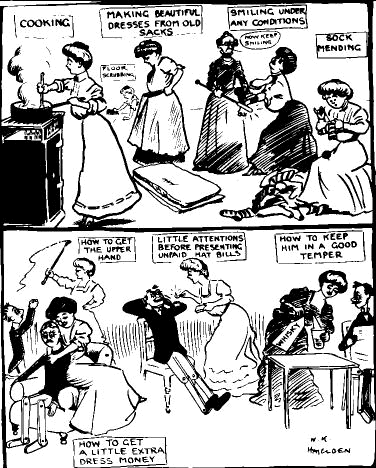|
|
|
Nineteenth Century changesVictorian women had few civil or political rights. A wife had to do as she was told by her husband, who was her protector and adviser. Until 1884 a wife was officially listed as one of her husband’s possessions. In addition, Victorian women were expected to live up to an image of ‘the perfect being’ – beautiful, demure, loving and intelligent. Many women actively agreed with this attitude (Source A). As the 19th century progressed, women were given a number of civil rights, including the right to vote in local elections (Source B). But by 1900 they had still not been given the right to vote in Parliamentary elections.
Source AA woman should make a man’s home delightful. Their sex should ever teach them to be subordinate. Women are like children; the more they show they need looking after, the more attractive they are. Mrs John Sandford, Woman in her Social and Domestic Character (1837).
Source BWomen’s Rights in the 19th Century 1857: Matrimonial Causes Act – a woman can divorce her husband if he beats her or commits adultery. 1882: Married Woman’s Property Act – married women allowed to own property and to keep their own earnings. 1907: women ratepayers were allowed to vote in local elections.
|
Going DeeperThe following links will help you widen your knowledge: Victorian Women including the 'Happy Women' game
Victorian
women - an old BBC site
This 1907 cartoon takes a humorous look at how a good wife should behave.
|
The Campaign for the VoteIn 1866, a number of women took a petition, signed by 1,500 women and asking for the vote, to Parliament, where two of the handful of pro-vote MPs presented it. In 1897, the various women’s societies joined together into the National Union of Women’s Suffrage Societies (NUWSS). These ‘Suffragists’ as they were called, campaigned peacefully for the vote. Although the number of pro-suffrage MPs in the House of Commons grew, the Suffragists got nowhere. In 1903, therefore, Emmeline Pankhurst formed the Women’s Social and Political Union (WSPU – see Source C). The ‘Suffragettes’, as they came to be called, were much more militant. They held mass-meetings, sent deputation to 10 Downing Street, interrupted from the Ladies Gallery during debates in the House of Commons and – eventually – burned, bombed and smashed to try to get the vote.
Source CIt is important that women should have the vote so that, in the government of the country, the woman’s point of view can be put forward. Very little has been done for women by legislation for many years. You cannot read a newspaper or go to a conference without hearing details for social reform. You hear about legislation to decide what kind of homes people are to live in. That surely is a question for women. No woman who joins this campaign need give up a single duty she has in the home. It is just the opposite, for a woman will learn to give a larger meaning to her traditional duties. From a speech made by Mrs Emmeline Pankhurst in March 1908.
Source D
A poster of 1912, produced by the Suffrage Atelier – an 'Arts and Crafts Society working for the enfranchisement of women'.
|
Millicent Fawcett speaking at a NUWSS rally in Hyde Park in 1913.
BBC site on Emmeline Pankhurst Spy pictures of suffragettes Detailed narrative - very dull
Why did the Suffragettes turn to violence? What did the Suffragettes do? - a list of actions What did the Suffragettes do? - a passage from Constance Rover. Suffragettes in prison - extracts from an article by Jane Purvis
YouTube: Sister Suffragette (song from Mary Poppins)
Consider:Read the information on this web page. List all the reasons you can infer as to why women were not given the vote before 1914.
|
|
| |


